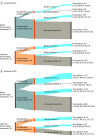Margin Assessment Methods in Oral Cavity Squamous Cell Carcinoma and Recurrence: Tumor Bed vs Resection Specimen Sampling
- PMID: 37768650
- PMCID: PMC10540056
- DOI: 10.1001/jamaoto.2023.2982
Margin Assessment Methods in Oral Cavity Squamous Cell Carcinoma and Recurrence: Tumor Bed vs Resection Specimen Sampling
Abstract
Importance: Positive margins and margin clearance are risk factors for recurrence in oral cavity squamous cell carcinoma (OCSCC), and these features are used to guide decisions regarding adjuvant radiation treatment. However, the prognostic value of intraoperative tumor bed vs resection specimen sampling is not well defined.
Objective: To determine the prognostic implications of intraoperative margin assessment methods (tumor bed vs resection specimen sampling) with recurrence among patients who undergo surgical resection for OCSCC.
Design, setting, and participants: This was a retrospective study of patients who had undergone surgical resection of OCSCC between January 1, 2000, and December 31, 2021, at a tertiary-level academic institution. Patients were grouped by margin assessment method (tumor bed [defect] or resection specimen sampling). Of 223 patients with OCSCC, 109 patients had localized tumors (pT1-T2, cN0), 154 had advanced tumors, and 40 were included in both cohorts. Disease recurrence after surgery was estimated by the cumulative incidence method and compared between cohorts using hazard ratios (HRs). Data analyses were performed from January 5, 2023, to April 30, 2023.
Main outcome and measures: Recurrence-free survival (RFS).
Results: The study population comprised 223 patients (mean [SD] age, 62.7 [12.0] years; 88 (39.5%) female and 200 [90.0%] White individuals) of whom 158 (70.9%) had defect-driven and 65 (29.1%) had specimen-driven margin sampling. Among the 109 patients with localized cancer, intraoperative positive margins were found in 5 of 67 (7.5%) vs 8 of 42 (19.0%) for defect- vs specimen-driven sampling, respectively. Final positive margins were 3.0% for defect- (2 of 67) and 2.4% for specimen-driven (1 of 42) margin assessment. Among the 154 patients with advanced cancer, intraoperative positive margins were found in 29 of 114 (25.4%) vs 13 of 40 (32.5%) for defect- and specimen-driven margins, respectively. Final positive margins were higher in the defect-driven group (9 of 114 [7.9%] vs 1 of 40 [2.5%]). When stratified by margin assessment method, the 3-year rates of local recurrence (9.7% vs 5.1%; HR, 1.37; 95% CI, 0.51-3.66), regional recurrence (11.0% vs 10.4%; HR, 0.85; 95% CI, 0.37-1.94), and distant recurrence (6.4% vs 5.0%; HR, 1.10; 95% CI, 0.36-3.35) were not different for defect- vs specimen-driven sampling cohorts, respectively. The 3-year rate of any recurrence was 18.9% in the defect- and 15.2% in the specimen-driven cohort (HR, 0.93; 95% CI, 0.48-1.81). There were no differences in cumulative incidence of disease recurrence when comparing defect- vs specimen-driven cases.
Conclusions and relevance: The findings of this retrospective cohort study indicate that margin assessment methods using either defect- or specimen-driven sampling did not demonstrate a clear association with the risk of recurrence after OCSCC resection. Specimen-driven sampling may be associated with reduced surgical margin positivity rates, which often necessitate concurrent chemotherapy with adjuvant radiation therapy.
Conflict of interest statement
Figures


Similar articles
-
Association of Main Specimen and Tumor Bed Margin Status With Local Recurrence and Survival in Oral Cancer Surgery.JAMA Otolaryngol Head Neck Surg. 2016 Dec 1;142(12):1191-1198. doi: 10.1001/jamaoto.2016.2329. JAMA Otolaryngol Head Neck Surg. 2016. PMID: 27423460
-
Independent Predictors of Prognosis Based on Oral Cavity Squamous Cell Carcinoma Surgical Margins.Otolaryngol Head Neck Surg. 2018 Oct;159(4):675-682. doi: 10.1177/0194599818773070. Epub 2018 May 8. Otolaryngol Head Neck Surg. 2018. PMID: 29737907 Free PMC article.
-
Specimen oriented intraoperative margin assessment in oral cavity and oropharyngeal squamous cell carcinoma.J Otolaryngol Head Neck Surg. 2021 Jun 21;50(1):37. doi: 10.1186/s40463-021-00501-5. J Otolaryngol Head Neck Surg. 2021. PMID: 34154663 Free PMC article.
-
Specimen-driven intraoperative assessment of resection margins should be standard of care for oral cancer patients.Oral Dis. 2021 Jan;27(1):111-116. doi: 10.1111/odi.13619. Epub 2020 Sep 13. Oral Dis. 2021. PMID: 32816373 Free PMC article. Review.
-
Margins in Stage I and II Oral Cavity Squamous Cell Carcinoma: A Review From the American Head and Neck Society.JAMA Otolaryngol Head Neck Surg. 2023 Jul 1;149(7):636-642. doi: 10.1001/jamaoto.2023.1201. JAMA Otolaryngol Head Neck Surg. 2023. PMID: 37289469 Review.
Cited by
-
GenAI synthesis of histopathological images from Raman imaging for intraoperative tongue squamous cell carcinoma assessment.Int J Oral Sci. 2025 Jan 26;17(1):12. doi: 10.1038/s41368-025-00346-y. Int J Oral Sci. 2025. PMID: 39865101 Free PMC article.
-
Impact of Close Margins on Oral Cancer Outcomes According to the Oral Subsite.Head Neck. 2025 Apr;47(4):1176-1184. doi: 10.1002/hed.28024. Epub 2024 Dec 9. Head Neck. 2025. PMID: 39648885 Free PMC article.
References
Publication types
MeSH terms
LinkOut - more resources
Full Text Sources
Medical
Miscellaneous

